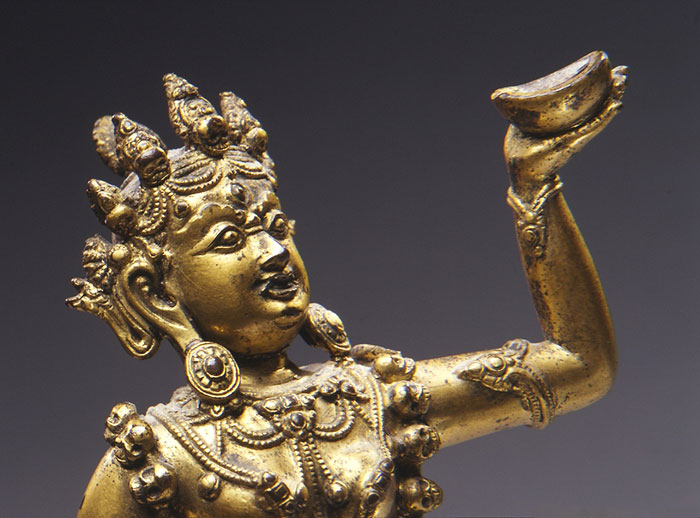previous image | Gallery 3: Tibet | next image

TIBET
20. Naro
Dakini
Tibeto-Chinese
Yongle mark and period, 1403-1424
Gilt copper alloy
H. 20.0 W. 16.5 D. 8.2
Collection Ethnographic Museum, Antwerp, inv.no.AE.2002.2.1
catalogue #75
Naro Dakini is an emanation of the goddess Vajrayogini, the archetypal female Buddha-deity and embodiment of Tibetan Buddhist wisdom. She is associated with the Cakrasamvara tantra cycle.1 The goddess is known as Naro Dakini after the legendary eleventh-century Indian mahasiddha Naropa chose this form of Vajrayogini as a tutelary deity. The dakini is thus important in the pantheon of the Tibetan Kargyu order, which includes Naropa in its lineage, and is also particularly venerated by the Sakya order. Both the Kargyu and the Sakya had influence at the court of the Chinese Yongle emperor where this image was commissioned. Records of the period contain numerous accounts of imperial gifts to visiting Tibetan lamas that included sculptures such as the Naro Dakini.2 To date, this rare and exquisite statue appears to be the only extant example of the subject to have been cast in the Yongle imperial ateliers. The goddess stands naked but for her
jewellery and a garland of human skulls. She holds a flaying knife
in her right hand and lifts a blood-filled skull cup in her left as
she prepares to drink.3 Two deities, Bhairava and Kalarati, are trampled
underfoot. The elegant oval lotus pedestal has the imperial six-character
Yongle reign mark incised on the forward edge of its upper surface.4
The bronze is finished to perfection with smooth gilded surfaces and
intricately worked details such as the skull garland and the elaborate
jewelled girdle hanging in festoons from the waist. There is animation
and delicacy in the sensuous female form with narrow shoulders and
waist, and slim and youthful arms and legs. Her face, however, is
grotesque, with bloodthirsty fangs and wide staring eyes, reminding
the viewer that she is no friend to desire and ego. 1.
For a comprehensive study of the Cakrasamvara tantra cycle, see Huntington
& Bangdel, 2003. |
all text & images © 2005 The authors, the photographers and the Ethnographic Museum, Antwerp
![]()
previous image | Gallery 3: Tibet | next image
